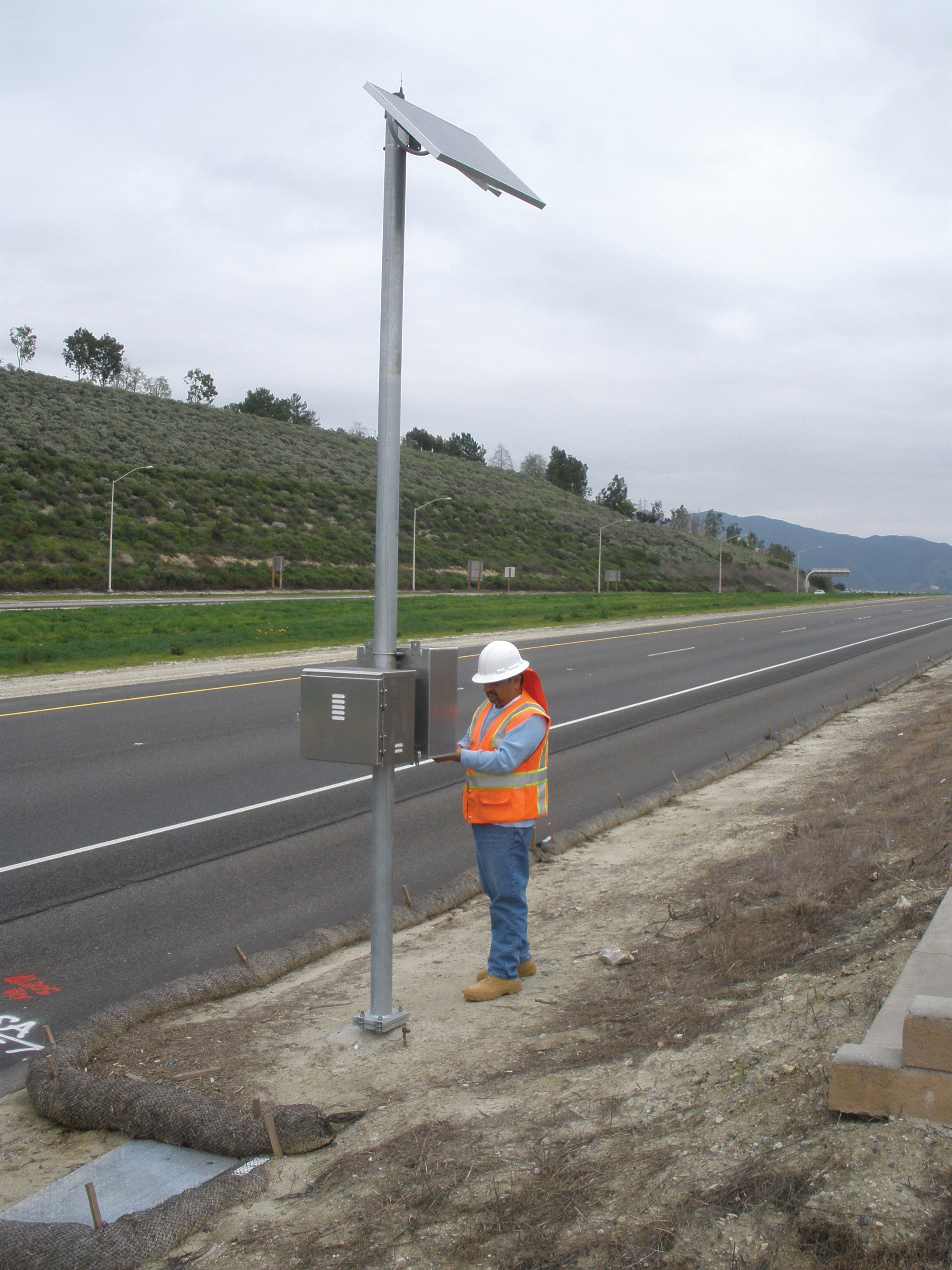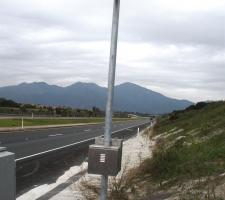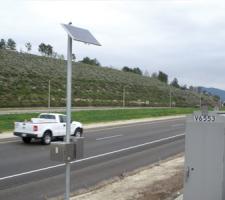
The deployment of 30 CGT units is currently serving as a test to evaluate the performance of the system
RSSPete Goldin reports on a new wireless, solar-powered traffic detection system being used by Caltrans District 12
As more and more traffic data is necessary to satisfy the needs of traffic management centres and traveller information systems, and as traffic detection technology becomes more ubiquitous, transportation authorities are pressured to find more economical ways of expanding their detection systems.3879 Caltrans (California Department of Transportation) District 12 is leading this push by deploying the latest detection system from 5857 Case Global Technologies (CGT), which includes cutting-edge functionality such as wireless communications, solar power and comprehensive remote performance monitoring.
The basis of the Caltrans detection system, even before the installation of the new CGT technology, has been traditional inductive loops embedded in the pavement of the highway to identify the quantity and speed of vehicles passing by. Currently, Caltrans's system includes 556 detection stations and 5,347 loops, which translates to about 10 to 14 loops per location.
"This system provides us with freeway and ramp data that helps us adjust our ramp metering rates during commuting hours," explains Saeed Nafisi, project engineer for Caltrans District 12. "It is also used to minimise delay on the freeway system."
The data is sent to the District 12 Traffic Management Center (TMC) in Irvine, California, every 30 seconds, and is used to help Caltrans manage incidents on the highway and other traffic issues. In addition, the information is communicated to the travelling public via such venues as 511, Traffic.com, Sigalert.com and changeable message signs along the roadway, to make drivers aware of freeway traffic conditions and give them the opportunity to take alternative routes, thereby reducing congestion.
"To accomplish this goal, however, we need to improve communication with our freeway detection systems in the field."
The main challenge Caltrans faces, in terms of this expansion, is the connectivity between the detection stations and the TMC. Most of the existing Caltrans detection stations require hardwired power and communication, such as fibre-optic or leased lines from the local phone company. The problem is that Caltrans needs to install some detection systems in areas along the freeway where telecoms companies do not currently offer phone services. Caltrans, meanwhile, does not operate fibre-optic lines. Access to power is also limited in these more remote areas.
In addition, leased lines and fibre-optic cables require conduit runs from the source or main trunk to the detection station cabinet. These conduit runs are easily damaged or covered by mud or other debris, which affects both communications and operation of the detection system.
"On top of that, our copper wires were stolen on some of our toll road facilities where there is little traffic during the day and after hours," Nafisi recalls. "We needed to come up with a new detection system that could solve these problems and fill the existing gap in coverage."
The TMS 300 is based on M2M (Machine-to-Machine) technology with an intelligent Java-enabled controller and wireless GSM communication technology. M2M technology enables the TMS 300 to provide rich traffic data with reliability exceeding 99 per cent. According to CGT, TMS 300 has 80 to 100 times less power consumption than a standard cabinet with similar functions.
Caltrans deployed 30 CGT units on the same toll road where the wire theft had occurred. This new system also uses wired loops placed in the pavement, but they deliver the traffic data to low-power detection cards that convert analogue information into digital counts. The information is stored in the memory of a wireless modem and transmitted to the District 12 TMC every 30 seconds using cellular technology. The use of wireless communication solves the major connectivity issue for Caltrans.
"In the past, the cost of a cellular system was high compared to the telephone leased lines," recounts Nafisi. "Additionally, network coverage was an issue for us, since there were not many sites where we needed the service. Historically, the speed and reliability of wireless were also challenges."
While the previous system was contained in a cabinet on ground level, the TMS 300 detection cards, modem, battery and other equipment are installed on a pole. Ease of pole installation enables Caltrans to implement the system safely near detection locations, while keeping it away from the travelling public.
The CGT system runs on battery power supplied by solar panels, with about 14 days of battery storage. After evaluation of the solar technology, Caltrans had to refine both battery size and solar panel size to ensure the system had enough power to process an average of six main lanes of freeway traffic data, even if sun energy was not available for approximately two weeks.
"The Solar TMS allows this advanced technology to be deployed anywhere that power is not available, therefore reducing cost and reducing pollution while providing rich, proven, reliable traffic data," says Sebastian Gutierrez, president of Case Global Technologies.
"CGT's new wireless solar-powered low-consumption system is in line with our general direction - to use green renewable solar energy systems in our designs," Nafisi explains, pointing out that this is the first time solar power has been used by Caltrans District 12 for a traffic management application. Previously, high cost and limited availability of technology made solar-powered detection stations unfeasible.
"Caltrans is pushing to use green renewable energy systems which are environmentally friendly," he adds. "Caltrans management would like us to use new and innovative renewable energy designs whenever possible."
All the communication methods except wireless require a physical connection between the field detection systems and the TMC, via wire or fibre-optic lines. Consequently, in the past, a detection system connection could go down due to a variety of reasons, including: rain; snow; wildfire; landslide; earth movement breaking the in-ground conduits; construction projects cutting into the existing power and communication lines; and even animals chewing the wires.
In addition, these hardwired connections go through multiple points of failure - pull boxes, service points, communication hubs, repeaters, multiplexers and so on. At any given time, any one of these devices could fail, disrupting the flow of data from the detection stations. The new system bypasses all these challenges.
"The CGT system costs us the same to communicate with the traffic management centre, compared with the leased line from a phone company," says Nafisi. "The advantage is that we do not have to worry about the communication network and connectivity. We do not need a separate service point from the power company and it eliminates the utility bill.
"In addition, we do not need to send our maintenance team to troubleshoot between the field equipment and the traffic management centre and look for problems, open pull boxes, and close lanes on the freeway," he adds. "The maintenance and trip costs would be minor since there are no wires between our TMC and the CGT field device. Our communication system will be up all the time, unless the cell network goes down - but that has never happened here."
Sensors are another feature offered by the CGT system to minimise downtime. Previously, Caltrans would have no way of knowing if a detection system was hit, power was out, wires were cut, multiplexers were burned out, communication lines or hubs were down or the phone company was experiencing a problem. The only information they had on detection system performance was if a specific detection station was not communicating with the TMC.
The new CGT system monitors all aspects of detection system performance, including if the device has been hit, the solar panel pole has been hit and tilted, the cabinet door has been opened by intruders, or the solar panel wire has been cut and is not charging the battery system. It also monitors battery level and loop operation, and alerts Caltrans through email and text message whenever there is an issue.
The deployment of 30 CGT units is currently serving as a test to evaluate the performance of the system. Caltrans is also comparing maintenance and troubleshooting costs for the new system against the traditional detection stations that connect to the TMC via phone lines and fibre optics to determine which option is more cost-effective.
"We have had a good experience with CGT and their products, and we will be recommending this system, along with other available systems, where it fits into future projects, as funds become available," Nafisi concludes. "Any new system deployment depends on funds availability and design requirement."RSS
As more and more traffic data is necessary to satisfy the needs of traffic management centres and traveller information systems, and as traffic detection technology becomes more ubiquitous, transportation authorities are pressured to find more economical ways of expanding their detection systems.
The basis of the Caltrans detection system, even before the installation of the new CGT technology, has been traditional inductive loops embedded in the pavement of the highway to identify the quantity and speed of vehicles passing by. Currently, Caltrans's system includes 556 detection stations and 5,347 loops, which translates to about 10 to 14 loops per location.
"This system provides us with freeway and ramp data that helps us adjust our ramp metering rates during commuting hours," explains Saeed Nafisi, project engineer for Caltrans District 12. "It is also used to minimise delay on the freeway system."
The data is sent to the District 12 Traffic Management Center (TMC) in Irvine, California, every 30 seconds, and is used to help Caltrans manage incidents on the highway and other traffic issues. In addition, the information is communicated to the travelling public via such venues as 511, Traffic.com, Sigalert.com and changeable message signs along the roadway, to make drivers aware of freeway traffic conditions and give them the opportunity to take alternative routes, thereby reducing congestion.
Communication gap
"To be able to respond to the traffic emergencies and incidents in a timely manner, Caltrans District 12 needs to have detection every half to two-thirds of a mile on every freeway in Orange County," Nafisi says. "The sooner we detect a situation and our emergency people respond to the incident or accident, the less back-up and delay to the travelling public."To accomplish this goal, however, we need to improve communication with our freeway detection systems in the field."
The main challenge Caltrans faces, in terms of this expansion, is the connectivity between the detection stations and the TMC. Most of the existing Caltrans detection stations require hardwired power and communication, such as fibre-optic or leased lines from the local phone company. The problem is that Caltrans needs to install some detection systems in areas along the freeway where telecoms companies do not currently offer phone services. Caltrans, meanwhile, does not operate fibre-optic lines. Access to power is also limited in these more remote areas.
In addition, leased lines and fibre-optic cables require conduit runs from the source or main trunk to the detection station cabinet. These conduit runs are easily damaged or covered by mud or other debris, which affects both communications and operation of the detection system.
"On top of that, our copper wires were stolen on some of our toll road facilities where there is little traffic during the day and after hours," Nafisi recalls. "We needed to come up with a new detection system that could solve these problems and fill the existing gap in coverage."
Cutting the wires
To solve the challenges, Caltrans deployed the Solar Traffic Monitoring Solution (TMS 300) from CGT. This is a wireless, solar-powered traffic monitoring solution.The TMS 300 is based on M2M (Machine-to-Machine) technology with an intelligent Java-enabled controller and wireless GSM communication technology. M2M technology enables the TMS 300 to provide rich traffic data with reliability exceeding 99 per cent. According to CGT, TMS 300 has 80 to 100 times less power consumption than a standard cabinet with similar functions.
Caltrans deployed 30 CGT units on the same toll road where the wire theft had occurred. This new system also uses wired loops placed in the pavement, but they deliver the traffic data to low-power detection cards that convert analogue information into digital counts. The information is stored in the memory of a wireless modem and transmitted to the District 12 TMC every 30 seconds using cellular technology. The use of wireless communication solves the major connectivity issue for Caltrans.
"In the past, the cost of a cellular system was high compared to the telephone leased lines," recounts Nafisi. "Additionally, network coverage was an issue for us, since there were not many sites where we needed the service. Historically, the speed and reliability of wireless were also challenges."
While the previous system was contained in a cabinet on ground level, the TMS 300 detection cards, modem, battery and other equipment are installed on a pole. Ease of pole installation enables Caltrans to implement the system safely near detection locations, while keeping it away from the travelling public.
Here comes the sun
The solar power feature offered by CGT was a major attraction for Caltrans, as it frees the agency not only from hardwired communication lines but also power lines.The CGT system runs on battery power supplied by solar panels, with about 14 days of battery storage. After evaluation of the solar technology, Caltrans had to refine both battery size and solar panel size to ensure the system had enough power to process an average of six main lanes of freeway traffic data, even if sun energy was not available for approximately two weeks.
"The Solar TMS allows this advanced technology to be deployed anywhere that power is not available, therefore reducing cost and reducing pollution while providing rich, proven, reliable traffic data," says Sebastian Gutierrez, president of Case Global Technologies.
"CGT's new wireless solar-powered low-consumption system is in line with our general direction - to use green renewable solar energy systems in our designs," Nafisi explains, pointing out that this is the first time solar power has been used by Caltrans District 12 for a traffic management application. Previously, high cost and limited availability of technology made solar-powered detection stations unfeasible.
"Caltrans is pushing to use green renewable energy systems which are environmentally friendly," he adds. "Caltrans management would like us to use new and innovative renewable energy designs whenever possible."
Minimal downtime
One of the major benefits Caltrans gains from the new system is increased uptime, due to the solar power, wireless communication and performance sensors.All the communication methods except wireless require a physical connection between the field detection systems and the TMC, via wire or fibre-optic lines. Consequently, in the past, a detection system connection could go down due to a variety of reasons, including: rain; snow; wildfire; landslide; earth movement breaking the in-ground conduits; construction projects cutting into the existing power and communication lines; and even animals chewing the wires.
In addition, these hardwired connections go through multiple points of failure - pull boxes, service points, communication hubs, repeaters, multiplexers and so on. At any given time, any one of these devices could fail, disrupting the flow of data from the detection stations. The new system bypasses all these challenges.
"The CGT system costs us the same to communicate with the traffic management centre, compared with the leased line from a phone company," says Nafisi. "The advantage is that we do not have to worry about the communication network and connectivity. We do not need a separate service point from the power company and it eliminates the utility bill.
"In addition, we do not need to send our maintenance team to troubleshoot between the field equipment and the traffic management centre and look for problems, open pull boxes, and close lanes on the freeway," he adds. "The maintenance and trip costs would be minor since there are no wires between our TMC and the CGT field device. Our communication system will be up all the time, unless the cell network goes down - but that has never happened here."
Sensors are another feature offered by the CGT system to minimise downtime. Previously, Caltrans would have no way of knowing if a detection system was hit, power was out, wires were cut, multiplexers were burned out, communication lines or hubs were down or the phone company was experiencing a problem. The only information they had on detection system performance was if a specific detection station was not communicating with the TMC.
The new CGT system monitors all aspects of detection system performance, including if the device has been hit, the solar panel pole has been hit and tilted, the cabinet door has been opened by intruders, or the solar panel wire has been cut and is not charging the battery system. It also monitors battery level and loop operation, and alerts Caltrans through email and text message whenever there is an issue.
The deployment of 30 CGT units is currently serving as a test to evaluate the performance of the system. Caltrans is also comparing maintenance and troubleshooting costs for the new system against the traditional detection stations that connect to the TMC via phone lines and fibre optics to determine which option is more cost-effective.
"We have had a good experience with CGT and their products, and we will be recommending this system, along with other available systems, where it fits into future projects, as funds become available," Nafisi concludes. "Any new system deployment depends on funds availability and design requirement."RSS














